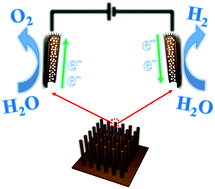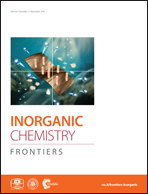Hierarchically structured CoN/Cu3N nanotube array supported on copper foam as an efficient bifunctional electrocatalyst for overall water splitting†
Abstract
Exploring nonprecious, efficient and stable electrocatalysts for overall water splitting is of great importance, but it is also challenging. In this study, N-doped carbon@ CoN/Cu3N/copper foam (namely, NC@CoN/Cu3N/CF) nanoarrays with a hollow tubular structure have been successfully synthesized through a facile method. The as-produced NC@CoN/Cu3N/CF with a 3D hierarchical structure was highly beneficial for electrocatalysis; it displayed improved electrical conductivity, abundant exposed active catalytic sites, numerous “highways” for charge transport and synergistic effect of each component. The enhanced characteristics resulted in largely improved kinetics and activity for the oxygen evolution reaction (OER) and hydrogen evolution reaction (HER). The NC@CoN/Cu3N/CF electrode exhibited low overpotentials of 303 mV to reach a current density of 50 mA cm−2 for OER and 134 mV to reach a current density of 10 mA cm−2 for HER in an alkaline solution. Furthermore, as an electrocatalyst for overall water splitting, NC@CoN/Cu3N/CF served as both the anode and cathode, delivering a current density of 10 mA cm−2 at a quite low cell voltage of 1.62 V, and it displayed excellent long-term stability (15 h at 20 mA cm−2). This study provides a rational strategy and approach to fabricate transition metal nitrides with 3D hierarchical structures as efficient electrocatalysts in renewable energy applications.



 Please wait while we load your content...
Please wait while we load your content...